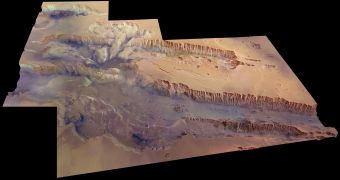Mars has many wonders and, as the closest planet that we can explore relatively easy, many of them have been discovered. But as a rather small planet, you wouldn't expect it to stand out too much in our Solar System and you'd expect it to hold few "biggest …" titles.
But it does, it's home to the tallest mountain, a volcano, in the Solar System, Olympus Mons, and the biggest canyon, Valles Marineris, which is thought to have been formed under the influence of the former.
The European Space Agency has now published a new image of the canyon, created from data from the Mars Express probe, which showcases the beauty and the size of the giant canyon. If you want the huge 9 MB full-res JPEG or the humongous 190 MB TIFF, you can find them here.
"This bird’s-eye view of Valles Marineris was created from data captured during 20 individual orbits of ESA’s Mars Express. It is presented in near-true colour and with four times vertical exaggeration," ESA explained.
"A wide variety of geological features can be seen, reflecting the complex geological history of the region," it said.
At 4,000 km, 2,500 miles long, enough to stretch from one end of the US to the other, and 200 km, 125 miles wide, the canyon occupies an important part of the Martian landscape.
And, at 10 km, 6 miles deep, it's by far the deepest canyon in the Solar System. Its origins have been debated for long, but the most popular theory is that it was created by Mars' tectonic movement and volcanic activity, several billion years ago. But its shape was later altered by water streams and landslides.
"The canyon’s formation is likely intimately linked with the formation of the neighbouring Tharsis bulge, which is out of shot and to the left of this image and home to the largest volcano in the Solar System, Olympus Mons," ESA explained.
"The volcanic activity is revealed by the nature of the rocks in the walls of the canyon and the surrounding plains, which were built by successive lava flows," it added.

 14 DAY TRIAL //
14 DAY TRIAL //